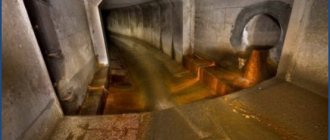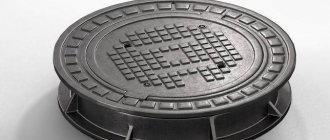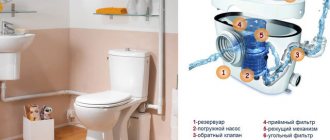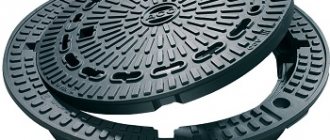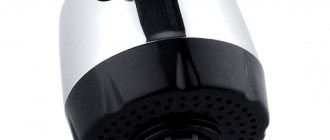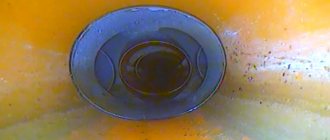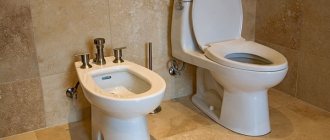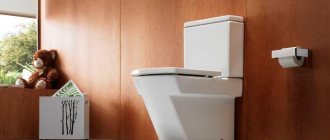A shower drain or gutter drainage system is a universal design designed to effectively remove non-aggressive liquids, including water, from the floor surface in special rooms.
Shower drain
Long grated shower drain
Structural characteristics and purpose
The shower drain belongs to the category of complex plumbing devices, and is fixed directly to the pipeline through a special floor hole. This design includes:
- funnel-shaped water inlet or housing;
- siphon, responsible for creating an effective hydraulic seal;
- a flange through which the waterproofing membrane part is sealed;
- a grate that prevents clogging and failure of the sewer system;
- outlet coupling part connected to the drain part of the sewer system.
Drain drain assembly diagram
During operation of the drain ladder, the entire device must be securely fixed, and the removable part is represented only by a lattice cover. Most shower drain devices are installed in the floor, but some models are built directly into the wall.
Decorative drain gratings
Despite their apparent simplicity, drainage structures have a wide range of functionality:
- transport the water flow to the sewer riser;
- provide optimal tightness of the joint with the floor;
- carry out primary filtration of wastewater and prevent sewer clogging.
The built-in hydraulic seal prevents all unpleasant sewer odors from entering the room.
How to choose
Having figured out what a drain in a sewer is, you need to select a sample for an apartment or other room. The main selection criterion will be the height of the podium or screed. If it is small, horizontal structures should be considered. For higher support platforms, vertical (straight) types are suitable.
The choice of material is made based on the load on the drain. If the drain is located under your feet and people will often step on it, it is better to use a steel sewer drain. This option is also good if the entire assembly is poured into the screed. If the drain is located near the wall and will not experience stress, it is easier to choose an inexpensive plastic product.
In addition, it is useful to choose devices with the ability to adjust the height (or depth of immersion in the hole). If the structure is vertical (straight), the size of its connecting pipe is usually 110 mm. For horizontal devices, 50 mm pipes are used.
Recommendations for selection
When choosing a special element of plumbing communications intended for drainage of wastewater into the sewer system, you must first of all pay attention to such a very important parameter as throughput indicators, indicating the amount of water that the drain can consistently discharge per unit of time. As a rule, the standard calculation of the required throughput is based on the following data:
- with a diameter of the upper shower head of 300 mm, the average water supply per hour varies between 30-90 l;
- using a cascade shower requires water consumption in the range of 1500-1800 liters per hour.
When choosing throughput, it is advisable to take into account a small margin of 5-10%, which will prevent emergency situations and flooding.
If you need to perform independent installation and have no experience in plumbing work, it is not advisable to purchase round models. It will be quite problematic to perform a perfectly smooth and beautiful installation of the floor covering when installing such a ladder with your own hands.
Corner round drain
Types of materials for equipment production
In accordance with the material from which the drain parts are made, the following types of products are distinguished:
- cast iron has the largest capacity, but is heavy and difficult to install. Can be used in difficult conditions. Used in factories, swimming pools, public toilets;
- plastic ones are resistant to aggressive influences, weigh little, have low cost, are durable, and do not require special operating conditions. Polymer products are widely used when installing a do-it-yourself drainage system for various sanitary facilities;
- Stainless steel drains are used in premises where it is necessary to ensure compliance with high sanitary requirements: hospitals, kindergartens, catering establishments. The metal body is easy to clean from dirt, and the products are easy to install.
Plastic drain Stainless steel drain
Cast iron horizontal drain
To install a drain system for a shower stall with your own hands in an apartment or house, it is recommended to use plastic or steel products.
Installation technology
A properly selected shower drain is resistant to corrosive changes, and is also characterized by reliability and durability. If necessary, this structure can be disassembled and cleaned independently.
Step 1. Areas of all joints of the floor and walls, as well as corners, are carefully treated with mastic, which prevents the ingress of moisture, as well as the formation of mold and foci of fungal infection.
Step 2. Assembling and subsequent installation of the drainage system, which should be located on a straight line between the section where it inserts into the sewerage system and the junction of the floor tile elements.
Step 3. Inserting into the sewer and processing the connection using silicone plumbing sealant. If it is necessary to connect drain pipes from a large number of plumbing fixtures, use a standard adapter for several outlets.
Step 4. Additional thermal insulation of the concrete base using granulated or extruded polystyrene foam sheets. The contours of the installed elements of the drainage system are carefully cut out using a construction knife.
Additional thermal insulation of the concrete base
Laying thermal insulation
Laying insulation and installing a ladder
Installing a siphon
At this stage, it is possible to replace heat-insulating materials with a cement-sand screed.
Step 5. Lay plastic deformation borders or damping self-adhesive tape along all walls.
Step 6. Mixing the cement mortar and applying it to the polystyrene foam surface in a layer of 3.5-4.0 cm. The mixture to be laid should completely hide the installed drain without a flange. Leveling the cement mixture is carried out according to construction rules.
Insulation
Screed
Further work should be carried out approximately three to four days after the concrete screed has hardened well and gained full strength.
Cladding walls while the screed is drying
Step 7. Prepare a gasket with a diameter of 15-20 cm from an isoplastic membrane with a hole in the central part, and then fix it with a screw around the flange.
Step 8. An additional layer of waterproofing should also be provided in the corners, at the joints and along the entire surface under the shower stall. After treatment with the primer, a layer of coating mastic is applied.
Application of primer
Additional layer of waterproofing and installation of a drain pipe
Step 9. Connecting the siphon and the grille with a gasket in the form of a rubber O-ring.
Sealing ring
Waterproofing
When installed correctly, the decorative grille can be easily dismantled, making the inside of the drain accessible for work. The cover must be covered with polyethylene, which will prevent cement mortar from getting into the drain system.
Step 10. Applying another layer of cement screed. When the drain hole is located in the central part of the shower room, guides are installed in a diagonal direction, the lower corner of which should converge at the drain. The resulting triangle is also filled with the mixture.
Guides
Pouring the mixture
Pouring a screed with a slope
The hardening cement mixture must be periodically moistened and thoroughly leveled. At the final stage, the guides are removed, and the freed space is filled with cement mixture.
Design Features
According to their design features, the most popular are horizontal drains, in which wastewater is discharged to the side. They are easy to install with your own hands, even in multi-story buildings. The vertical device requires complex installation, but has a higher throughput. Horizontal equipment must have a sleeve cross-sectional size corresponding to the diameter of the sewer pipeline of 5 cm; for vertical devices, the cross-sectional diameter is 11 cm.
The height of the sewer drain is selected taking into account the height of the shower stall floor, in the range of 7.5-18 cm. It is necessary to correctly calculate the height of the device so that after its installation the upper part does not protrude above the floor surface.
Types of shower drains in the floor under tiles
The sewer drain can have different throughput and diameter of the drain hole. For an apartment, it is recommended to install equipment with a throughput capacity of at least 1.2 l/sec. The removable grill can be square, round or rectangular. It is easier to lay tiles around square and rectangular drain holes and fewer cut pieces will be required. This must be taken into account when choosing a ladder.
Types of sewer drains
Example of a corner shower drain
Ladder with dry seal
Expert advice
The most convenient, from the point of view of self-assembly, reliability and durability, is the purchase and installation of the most modern, ready-made type-setting structures, represented by perforated metal-plastic. It is recommended to apply red lead to the mounted surface of steel structures.
The ceramic floor covering used in the construction of the drain must meet increased requirements. The surface of the tile should not be slippery or absorb significant amounts of moisture. The moisture absorption level should be 1.5% or less of the weight of the tile itself.
Finishing work
The ladder is installed
Video: Laying tiles on the floor using MAGIC part 1
Video: Laying tiles with a slope under the drain in the shower, part 2
Video: Laying tiles on the floor, with a slope to drain water, part 3
Surface roughness increases operational safety and prevents slipping when water enters. Installation is carried out using special adhesive contact compounds. All seam joints between the elements of the tile covering are sealed exclusively with waterproof grout, which can be the same color as the main coating or have a contrasting color. Learn how to install a heated towel rail in a bathroom using this link.
Floor drain
Review of prices for different equipment models
The table provides a reference overview of prices for domestically produced models based on the results of monitoring offers from online construction stores.
| Type of equipment | Material | Average price, rubles |
| Horizontal with water seal | stainless steel | 2900 |
| plastic | 2200 | |
| Vertical with water seal | stainless steel | 4900 |
| plastic | 3700 |
Installation Requirements
For the correct and uninterrupted operation of shower drains, it is necessary to take into account their throughput, design features, and adhere to installation technology.
Basic conditions to follow during installation:
- when installing a vertical drain, the cross-section of the outlet pipe must correspond to the diameter of the sewer pipe, which is 110 mm. For horizontal connection, the cross-section of the sleeve can be from 50 mm;
- the ladder grate should be 1-2 mm below the finished floor covering;
- all seams, abutments, joints and connections of pipes are carefully sealed and waterproofed;
- When performing each stage of work, it is necessary to strictly control the slopes.
The installation location of the shower drain is determined depending on the location of the sewer risers in the room and the drainage capacity.
What is the difference between a ladder and a tray?
In simple terms, a shower drain differs from a tray in size and appearance. A drainage device with a square or round grate is called a drain. A shower tray is a drainage channel with a rectangular grille.
Since the trays have a larger grid area, they also have a larger area for collecting water from the floor. Many people think that if the shower tray is larger than the drain, then the water will flow into it faster. However, this is not quite true. I'll explain why a little later.
Rating
My rating contains water drainage devices only from those manufacturers whose products I have ever installed. Based on my experience, I can say that European manufacturers all make good products; when purchasing, you need to look at the price and equipment.
And so they are more or less all the same. I do not recommend purchasing cheap Chinese and Turkish trays and ladders. Replacing a drain costs 10-20 times more than the cost of the product + installation. I think it is better to initially buy a higher quality product.
My rating of point drains
Shower drain Tim BAD011002
This product has 2 advantages:
- Low cost, about 500 rubles;
- Small height - 67 mm.
Among the disadvantages: the ladder must initially be set exactly at the height of the finishing floor covering. No dry shutter. Of the 4 drains purchased by the customer, 3 leaked at the welding site. Maybe it was a defective batch, but I installed these ladders only once and didn’t risk it again.
Bath drain, shower drain TECE S110
Several times we had to install such ladders. When purchasing, you need to look at the package. The set may not include legs and a dry siphon. I can’t say anything bad about this ladder, but, in my opinion, the price is a bit high.
Drain drain AlcaPlast
The Czech manufacturer AlcaPlast produces many products for draining water. Among everything I've put on, this is a solid average. On the one hand, the plastic is flimsy, on the other hand, there have never been any problems with these ladders and trays.
Point shower drain Aco
These products are of high quality with an increased throughput of up to 120 liters per minute. Suitable for any rain shower. The cost is also high. I installed them several times, but they were strong and reliable, but expensive.
Viega Advantix shower drain
I like these ladders most of all due to the price-quality ratio. That's why I installed them most in my life. I don’t know the exact number, but I definitely supplied a couple of hundred pieces. There are no problems with them. Dry shutter included. The plastic is strong.
My rating of shower trays
Drainage channel AlcaPLAST Simple
Pros: good quality plastic. Waterproofing tape included. Combined siphon, when water evaporates, no odor will appear in the room.
Disadvantages: I didn’t like how the legs were adjusted. Low flow rate: 28 liters per minute. I wouldn't install one like this for a rain shower.
Gutter trays ACO (Ako)
They are made in Germany from high quality stainless steel. This is a premium brand, so they are relatively expensive, but there are several budget models. I only installed this once. I can't say anything bad.
Drainage channel TECE TECElinus
They also make it in Germany and the price is also high: trays from 15 thousand rubles and a grill will cost another 5 thousand. I can't say anything bad, but it seems to me that the price is too high.
Shower tray Viega Advantix
Made in Germany. Drainage channels were made of stainless steel or plastic + stainless steel. Good quality. I have never had any problems with the products of this brand, I recommend it for purchase . But the price tag is also not cheap and starts from 15 thousand rubles.
MIANO gutter trays
Over the last year I have been recommending them to all my customers. Made in the Czech Republic. The plastic is strong. There are cases in charcoal black, which looks cool. Everyone usually has gray plastic.
Drainage channel complete with water seal and dry seal. High flow rate: suitable for rain showers.
Convenient adjustment of legs during installation. They can be twisted directly through the body with a screwdriver. This speeds up installation of the tray significantly.
Waterproofing included. At the same time, the price tag is average. In my understanding, these gutters are ideal in terms of price-quality ratio.
I buy MIANO shower trays in the Akvamosaika online store ; these products are not sold in offline stores in my city.
Types of design grids
A modern range of gratings (the visible part) of the drain will satisfy the taste of any buyer. They can be divided into the following options:
- Stainless steel gratings, perforated.
- Stainless steel gratings.
- Glass grilles (glass is glued into a metal box).
- Grids for tiles (for laying tiles or facing stones in them).
- Insert design for slotted drains.
It is worth paying attention to the drains from the Pestan factory with a 2 in 1 grid.
Example 1:
The design of the grid in this drain can be used both for laying tiles and depending on the mood; it can be turned upside down, thereby changing the design of the bathroom).
Example 2:
Today white glass, and tomorrow an all-metal grille.
Of special note are the new products from Geberit and TESE factories.
, where the design of the grille is a drainage chute, which, according to the manufacturers, makes cleaning easier and prevents debris and bacteria from accumulating.
